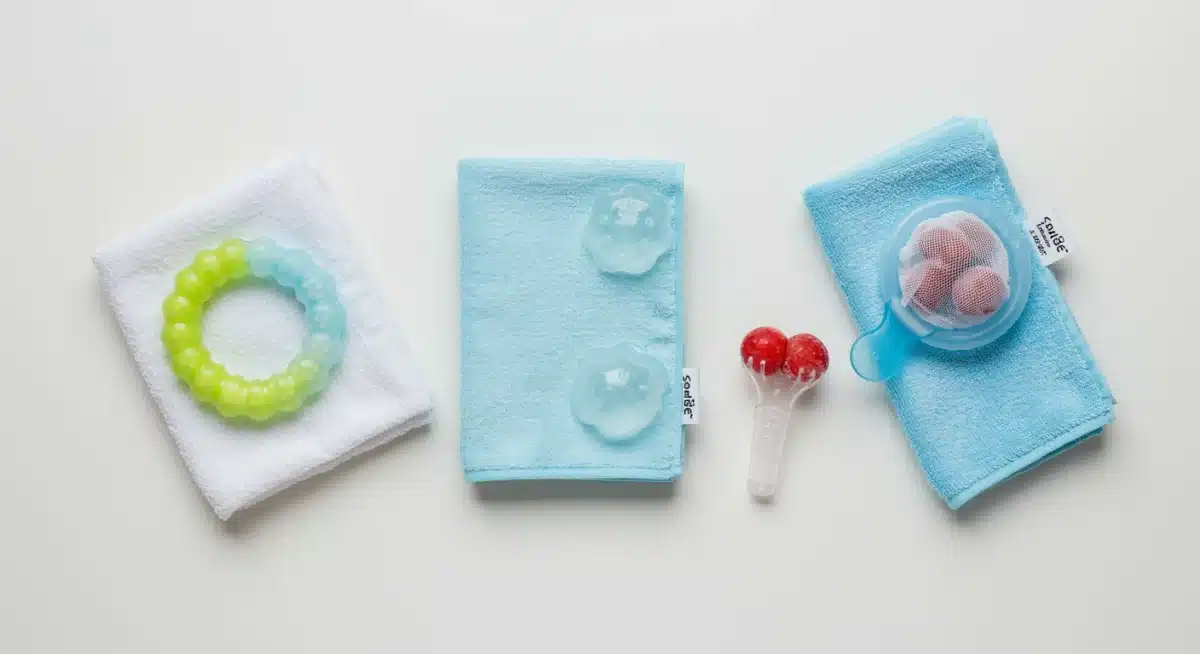Teething Troubles? Proven Methods to Relieve Baby Discomfort

Advertisement
Understanding and addressing baby teething relief is crucial for parents, involving various gentle and effective strategies to alleviate discomfort and support healthy development.
Is your little one suddenly fussy, drooling more, and gnawing on everything in sight? If so, you’re likely navigating the often challenging, yet completely normal, phase of baby teething relief. This period, while a significant developmental milestone, can bring considerable discomfort to your baby and, by extension, to you. Understanding the signs, knowing what to expect, and having a toolkit of proven methods can make all the difference in soothing your child and bringing a sense of calm back to your home.
understanding the signs of teething
Teething is a natural process where a baby’s first teeth cut through the gums. While exciting, it’s often accompanied by a range of symptoms that can vary significantly from one baby to another. Recognizing these signs early can help parents respond effectively and provide timely comfort.
Advertisement
Typically, teething begins around six months of age, but it can start as early as three months or as late as twelve months. The first teeth to appear are usually the bottom front teeth (central incisors), followed by the top front teeth, then the lateral incisors, canines, and finally, the molars. This process can continue until a child is around two and a half to three years old.
common teething symptoms
Many parents report a cluster of symptoms when their baby is teething. These can range from mild irritation to more noticeable distress. It’s important to differentiate these from signs of illness, though sometimes the two can overlap.
- excessive drooling, which can sometimes lead to a rash around the mouth and chin.
- irritability and fussiness, often more pronounced at night.
- chewing on hands, toys, or anything within reach, often with increased intensity.
- swollen, tender, or red gums, which might appear slightly bruised.
- slight increase in temperature (not usually a fever above 101°F or 38.3°C).
- difficulty sleeping and changes in feeding patterns.
While some babies sail through teething with minimal fuss, others experience significant discomfort. Observing your baby closely and understanding their unique cues is key to providing appropriate relief. Remember, if you’re ever concerned about your baby’s symptoms, especially if they include a high fever or severe diarrhea, it’s always best to consult with your pediatrician to rule out other issues.
Advertisement
gentle gum massage and pressure
One of the most immediate and effective ways to provide baby teething relief is through gentle gum massage and the application of pressure. The counter-pressure can help alleviate the throbbing sensation and soreness associated with erupting teeth. This method is not only soothing but also provides a comforting physical connection between parent and child.
Before attempting any gum massage, ensure your hands are thoroughly clean. Wash them with soap and warm water, or use an alcohol-based hand sanitizer. You can use your clean finger to gently rub your baby’s gums. Apply light pressure in circular motions on the sore areas. Many babies find this incredibly soothing and may even lean into the pressure.
safe teething toys and tools
Beyond your fingers, a variety of safe teething toys and tools can provide the necessary counter-pressure. These are designed with different textures and shapes to reach various parts of the gums and offer varied sensations.
- silicone or rubber teething rings: choose those that are BPA-free and easy for your baby to grasp.
- chilled teething toys: cooling can numb the gums slightly, offering additional relief. Ensure they are not frozen solid, as this can be too harsh for delicate gums.
- wet washcloths: a clean, damp washcloth, chilled in the refrigerator, can be folded and offered to your baby to chew on.
- teething mittens: these are particularly useful for younger babies who haven’t yet developed the dexterity to hold a teething toy.
Always supervise your baby when they are using teething toys to ensure their safety and prevent choking hazards. Regularly inspect teething toys for wear and tear, and clean them according to the manufacturer’s instructions. Providing a variety of textures and temperatures can help your baby find what works best for them during this uncomfortable phase.

cooling and soothing techniques
The application of cool temperatures can be a highly effective way to numb sore gums and reduce inflammation, offering significant baby teething relief. This approach provides a temporary respite from the persistent ache of erupting teeth. It’s important to use cooling methods safely to avoid causing further discomfort or injury to your baby’s delicate mouth.
Chilled items work by constricting blood vessels in the gums, which can reduce swelling and pain. However, never use frozen items directly on your baby’s gums, as extreme cold can cause frostbite or damage the sensitive tissue. Refrigerated items are generally safe and effective.
effective chilled remedies
There are several safe and easy ways to incorporate cooling into your teething relief strategy. These methods are simple to prepare and can be rotated to keep your baby interested and comfortable.
- refrigerated teething rings: these are specifically designed for cooling and often have various textures for added stimulation.
- damp, chilled washcloth: soak a clean washcloth in water, wring it out, and place it in the refrigerator for 15-30 minutes. Your baby can then chew on the cool, damp cloth.
- mesh feeders with chilled fruit: for babies who have started solids, a mesh feeder filled with small pieces of chilled fruit like banana, apple, or melon can provide both nutrition and gum relief.
- cold water in a sippy cup: offering sips of cool water can also help soothe sore gums, especially for older babies.
Always ensure that any chilled items are clean and free from any sharp edges or small parts that could pose a choking hazard. Supervise your baby closely when they are using these items. The goal is to provide gentle, temporary relief without causing additional stress or risk. Experiment with different options to see what your baby prefers, as individual preferences can vary widely.
natural and herbal remedies
For parents seeking alternatives to traditional medications, several natural and herbal remedies can offer gentle baby teething relief. These options often focus on soothing inflammation and calming the baby without the use of synthetic ingredients. However, it’s crucial to approach these remedies with caution and always consult your pediatrician before introducing anything new to your baby’s routine.
Many cultures have historically used natural remedies for teething, passing down traditions through generations. While some of these remedies lack extensive scientific backing, many parents find them effective for their children. The key is to ensure safety and appropriate dosage, as babies are particularly sensitive to new substances.
popular natural soothing options
When considering natural relief, focus on ingredients known for their calming and anti-inflammatory properties. Always opt for products specifically formulated for infants and follow dosage instructions meticulously.
- chamomile: known for its calming properties, a very diluted chamomile tea (cooled) can sometimes be offered in tiny sips, or a chamomile-infused cloth can be applied to the gums.
- clove oil: extremely diluted clove oil (never apply undiluted) has been traditionally used for pain relief due to its eugenol content, but significant dilution is critical, and professional advice is paramount.
- amber teething necklaces: while popular, these are not recommended by pediatricians due to choking and strangulation hazards. There’s also no scientific evidence to support their efficacy.
- homeopathic remedies: some parents choose homeopathic gels or tablets. Discuss these with your pediatrician or a qualified homeopathic practitioner to ensure safety and suitability.
It’s important to remember that not all natural remedies are safe for babies. For instance, topical teething gels containing benzocaine are not recommended for infants due to potential serious side effects. Always prioritize safety and consult with a healthcare professional to ensure any natural remedy you choose is appropriate for your baby’s age and health status. The goal is to provide comfort, not to introduce new risks.
over-the-counter pain relief
When natural and physical methods aren’t enough to provide adequate baby teething relief, over-the-counter (OTC) pain relievers can be a safe and effective option. These medications are designed to reduce pain and inflammation, offering much-needed comfort to a distressed baby. However, it’s paramount to use them correctly, adhering strictly to dosage guidelines and consulting with your pediatrician.
OTC pain relievers work by targeting the underlying mechanisms of pain and inflammation. For teething, this means reducing the discomfort caused by swollen and tender gums. They should be considered a last resort when other methods have failed to provide sufficient relief, especially during periods of intense fussiness or disturbed sleep.
safe medication choices and dosages
The two most commonly recommended OTC pain relievers for infants are acetaminophen (Tylenol) and ibuprofen (Motrin, Advil). It’s crucial to use the infant formulations and to administer the correct dose based on your baby’s weight, not age, unless specifically directed otherwise by a doctor.
- acetaminophen (tylenol): generally recommended for babies 2 months and older. Always check the concentration of the liquid medication carefully, as it can vary.
- ibuprofen (motrin, advil): typically recommended for babies 6 months and older. It has anti-inflammatory properties, which can be particularly helpful for swollen gums.
- avoid aspirin: never give aspirin to infants or children due to the risk of Reye’s syndrome, a rare but serious illness.
- topical teething gels: avoid gels containing benzocaine, as they can cause a rare but serious condition called methemoglobinemia.
Always read the label carefully for dosing instructions and use the provided measuring device to ensure accuracy. Never exceed the recommended dose or administer more frequently than advised. If your baby’s pain persists or worsens despite medication, or if they develop a high fever or other concerning symptoms, contact your pediatrician immediately. Medications should be used judiciously and under professional guidance to ensure your baby’s safety and well-being.
maintaining hygiene and preventing rashes
Teething often brings an increase in drooling, which, while a natural part of the process, can lead to skin irritation and rashes if not managed properly. Maintaining good hygiene is a critical, yet often overlooked, aspect of providing comprehensive baby teething relief. Addressing these secondary symptoms can significantly improve your baby’s overall comfort during this challenging phase.
Excessive drool can keep the skin around your baby’s mouth, chin, and neck constantly wet. This moisture, combined with friction from clothing or pacifiers, creates an ideal environment for skin irritation, leading to a common condition known as a drool rash or teething rash. Preventing and treating these rashes is essential for your baby’s comfort.
practical hygiene tips for teething babies
Simple daily practices can go a long way in keeping your baby’s skin healthy and preventing uncomfortable rashes. Consistency is key when dealing with the continuous flow of drool.
- keep the skin dry: gently wipe away drool frequently with a soft, clean cloth. Avoid rubbing, which can further irritate delicate skin.
- use bibs: invest in several absorbent bibs and change them frequently throughout the day to prevent moisture from soaking into clothing and irritating the neck and chest area.
- apply a protective barrier: before bedtime or periods of heavy drooling, apply a thin layer of petroleum jelly or a pediatrician-recommended barrier cream to the affected areas.
- gentle cleansing: bathe your baby regularly using mild, unscented baby soap to keep the skin clean.
- avoid harsh products: steer clear of perfumed lotions, soaps, or wipes that could further irritate sensitive skin.
If a rash develops, continue with the hygiene practices and barrier creams. If the rash becomes severe, appears infected, or doesn’t improve with home care, consult your pediatrician. They may recommend a mild hydrocortisone cream or other treatment. By proactively managing drool and maintaining good skin hygiene, you can prevent additional discomfort and keep your baby’s skin healthy throughout the teething process.
when to consult a pediatrician
While teething is a normal developmental stage, it’s important for parents to recognize when a baby’s symptoms might indicate something more serious than just erupting teeth. Knowing when to consult a pediatrician is a crucial part of providing optimal baby teething relief and ensuring your child’s overall health and well-being. Trusting your parental instincts is vital, and when in doubt, it’s always best to seek professional advice.
Many of the symptoms associated with teething, such as fussiness and changes in appetite, can also be signs of other illnesses. It’s easy to attribute every symptom to teething, but some signs warrant a closer look by a healthcare professional. Differentiating between typical teething discomfort and a potential health issue is a key responsibility for parents.
red flags that require medical attention
Be vigilant for certain symptoms that are generally not caused by teething and should prompt a call to your pediatrician. Early intervention can prevent minor issues from becoming more serious.
- high fever: while a slight temperature increase is common with teething, a fever above 101°F (38.3°C) is usually not directly caused by teething and could indicate an infection.
- severe diarrhea or vomiting: these are not typical teething symptoms and could point to a gastrointestinal illness or other infection.
- persistent rash: if a rash extends beyond the mouth and chin area, is accompanied by fever, or doesn’t improve with hygiene and barrier creams, it needs medical evaluation.
- lack of appetite or refusal to feed for an extended period: while babies might eat less during teething, a complete refusal to feed for several meals warrants concern.
- unusual lethargy or extreme irritability: if your baby seems unusually tired, unresponsive, or is crying inconsolably, it’s time to contact your doctor.
Your pediatrician can provide reassurance, rule out other conditions, and offer guidance on managing severe symptoms. Never hesitate to call if you have concerns, even if they seem minor. It’s always better to be safe when it comes to your baby’s health. They are your best resource for personalized medical advice and support during your baby’s teething journey and beyond.
| Key Relief Method | Brief Description |
|---|---|
| Gentle Gum Massage | Apply light, circular pressure with a clean finger or safe teething toy to soothe sore gums. |
| Cooling Techniques | Offer chilled (not frozen) teething rings, wet washcloths, or mesh feeders with cold fruit to numb gums. |
| OTC Pain Relievers | Use infant acetaminophen or ibuprofen (6+ months) according to weight-based dosage, after consulting a pediatrician. |
| Hygiene & Rash Prevention | Keep drool-prone areas dry, use absorbent bibs, and apply barrier creams to prevent skin irritation. |
frequently asked questions about baby teething relief
The earliest signs often include increased drooling, fussiness, gnawing on objects, swollen or tender gums, and sometimes a slight increase in body temperature. These symptoms typically appear around 4-7 months, but can vary greatly among infants.
No, amber teething necklaces are not recommended by pediatricians. They pose significant choking and strangulation hazards, and there is no scientific evidence to support their claims of providing pain relief through succinic acid absorption.
While teething can cause a slight temperature elevation, a high fever (above 101°F/38.3°C) or severe diarrhea are not typical teething symptoms. If your baby experiences these, consult a pediatrician to rule out other illnesses.
Look for BPA-free silicone or rubber teething rings, chilled (not frozen) toys, or a clean, damp, chilled washcloth. Textured toys provide varied gum stimulation, and supervision is always essential when babies use them.
Consider pain medication like infant acetaminophen or ibuprofen (for babies 6+ months) when other soothing methods are insufficient and your baby is significantly distressed or unable to sleep. Always consult your pediatrician for proper dosage and guidance.
conclusion
Navigating the teething phase can be a challenging journey for both babies and parents, marked by discomfort and sleepless nights. However, by understanding the signs, employing a combination of proven relief methods, and knowing when to seek professional advice, parents can significantly ease their baby’s distress. From gentle gum massages and chilled toys to judicious use of over-the-counter pain relief and diligent hygiene, a comprehensive approach to baby teething relief can transform this developmental milestone into a more manageable experience. Remember, every baby is unique, so patience and observation are key to finding what works best for your little one, ensuring their comfort and well-being as those tiny teeth emerge.





